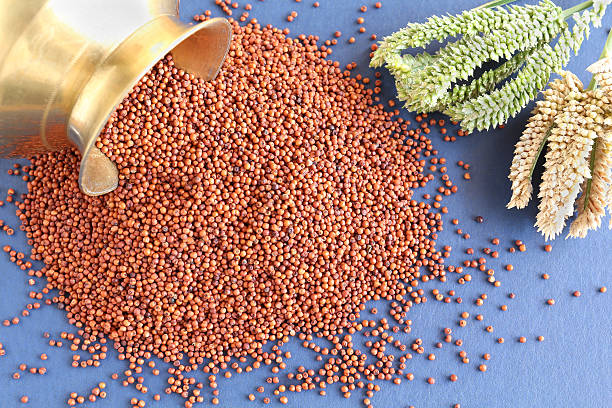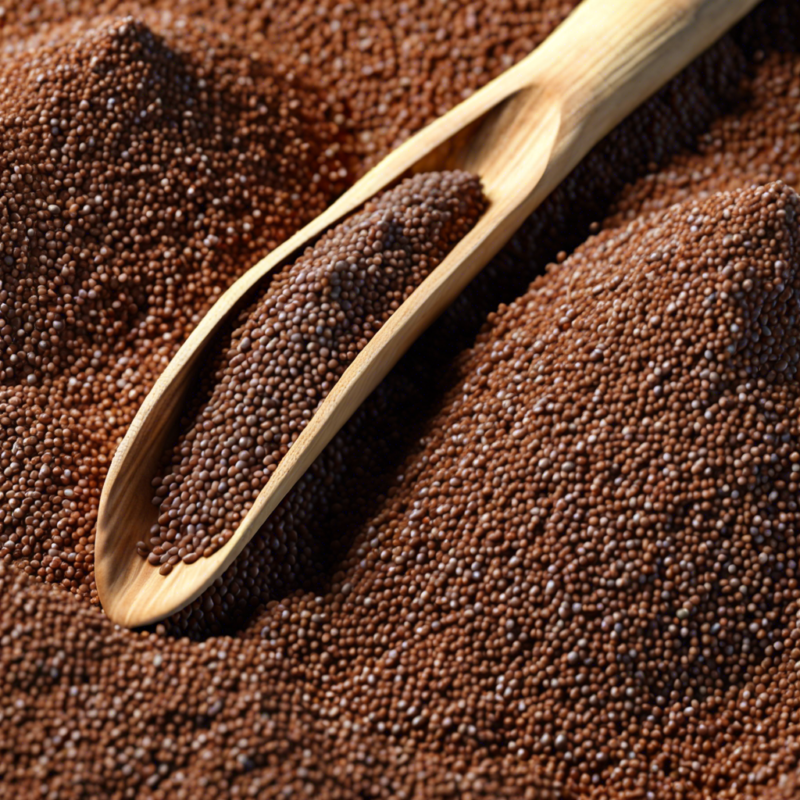Power of Finger Millet ( Ragi )
Finger Millet: A Nutrient-Packed Ancient Grain
Power of Finger Millet: A Nutrient-Rich Super Grain for Health and Wellness
Finger millet, scientifically known as Eleusine coracana, has been cultivated for thousands of years. Known as ragi in India, dagusa in Ethiopia, and kurakkan in Sri Lanka, this resilient crop thrives in arid and semi-arid regions. The power of finger millet lies in its exceptional nutritional profile and adaptability, which have made it a staple food in many parts of the world. In this blog, we will explore the history, cultivation, nutritional benefits, and culinary uses of finger millet, along with its impact on health and well-being.
A Grain with Historical and Cultural Importance
The power of finger millet lies in its nutritional value and its long-standing cultural and agricultural significance. Its origins trace back to the highlands of East Africa, particularly Ethiopia and Uganda, where it was cultivated over 5,000 years ago. By 3000 BC, finger millet had spread to India, especially in southern and western regions, becoming a dietary staple due to its ability to thrive in poor soils and drought conditions.
Its name comes from the unique finger-like arrangement of its seed head. These tiny grains can be stored for years, ensuring food security in areas prone to famine and scarcity. Today, as the world moves towards sustainable food sources, the power of finger millet is being rediscovered.
Nutritional Benefits of Finger Millet
The power of finger millet truly shines through its remarkable nutritional profile:
-
High Calcium Content: Approx. 350 mg per 100 grams—excellent for bones, especially for kids, pregnant women, and the elderly.
-
Rich in Fiber: Aids digestion, increases satiety, and helps manage weight.
-
Antioxidants: Contains polyphenols that combat oxidative stress and reduce the risk of chronic diseases.
-
Low Glycemic Index: Stabilizes blood sugar levels, ideal for diabetics.
-
Essential Micronutrients: Iron, magnesium, and other nutrients enhance overall health.
-
Naturally Gluten-Free: Perfect for those with gluten intolerance or celiac disease.
Culinary Uses and Everyday Inclusion
Finger millet’s versatility in the kitchen makes it easy to incorporate into a variety of meals. In India, it is ground into flour to prepare dishes like ragi roti (flatbread), ragi mudde (soft dough balls), and ragi dosa (savory pancakes). Meanwhile, African cuisines often feature finger millet in porridge or fermented beverages.
Incorporating finger millet into your meals can be as simple as substituting regular flour with ragi flour in baked goods or preparing a comforting bowl of millet porridge for breakfast. Its mild, nutty flavor complements both savory and sweet dishes, making it a favorite ingredient in modern recipes.
A Modern Superfood with Ancient Roots
Power of Finger Millet: A Nutrient-Rich Super grain for Health and Wellness as a Finger millet combines a rich history with significant health benefits, making it an excellent choice for anyone seeking a nutritious and sustainable grain. Its global popularity continues to rise as more people recognize its potential to address food security and promote healthy lifestyles. Whether you are looking to manage diabetes, improve bone health, or enjoy a gluten-free diet, finger millet proves to be a grain worth celebrating Indian Millets .

Health Benefits of Finger Millet
Finger millet is a powerhouse of nutrition, offering numerous health advantages. Here’s a breakdown of its key benefits:
Digestive Health
The high dietary fiber content in finger millet significantly supports digestion. Insoluble fiber bulks up the stool, promoting regular bowel movements and preventing constipation. At the same time, soluble fiber absorbs water, ensuring smooth digestive processes.
Bone Health and Calcium Supply
Rich in natural calcium, finger millet serves as an excellent plant-based source of this essential nutrient. It is particularly beneficial for individuals who are lactose intolerant or avoid dairy products. Regular consumption helps maintain bone density and prevents conditions like osteoporosis.
Anti-inflammatory Effects
Phenolic compounds and flavonoids present in finger millet help reduce inflammation. As a result, they lower the risk of chronic conditions, including arthritis and heart disease, while promoting overall well-being.
Skin Benefits
Finger millet contains amino acids such as methionine and lysine, which contribute to healthy skin. These amino acids promote collagen formation, which supports skin elasticity and delays signs of aging.
Stress Relief and Relaxation
Ragi includes tryptophan, a natural relaxant that triggers serotonin release in the brain. Consequently, this helps alleviate stress, improve mood, and promote relaxation, making it beneficial for mental health.
Immune System Support
Loaded with essential nutrients like iron, zinc, and magnesium, finger millet strengthens the immune system. These minerals ensure proper immune cell function and enhance the body’s natural defense mechanisms.
Benefits for Lactating Mothers
In many cultures, finger millet is recommended for lactating mothers. Its rich calcium and iron content not only supports milk production but also benefits both the mother and the baby.
Prevention of Gallstones
The insoluble fiber in ragi reduces bile acid secretion. By doing so, it helps prevent the formation of gallstones, offering a protective effect on digestive health.
Anemia Prevention
Finger millet combines iron with vitamin C, which enhances iron absorption in the body. This makes it particularly effective in preventing and managing anemia, especially in populations prone to iron deficiency.
Gluten-Free Benefits
As a naturally gluten-free grain, finger millet is a safe and nutritious choice for individuals with celiac disease or gluten intolerance. It allows for a variety of culinary uses without compromising health.
Metabolism Booster
Magnesium found in finger millet plays a critical role in metabolism. It supports energy production, DNA synthesis, muscle function, and several enzymatic reactions essential for overall health.
Hair Health
The combination of protein, iron, and amino acids in finger millet contributes to strong and healthy hair. Iron delivers oxygen to hair follicles, while amino acids promote keratin production, which strengthens hair strands.
Hormonal Balance
Lignans in finger millet mimic estrogen-like effects, which help balance hormone levels. This is especially beneficial for post-menopausal women, as it reduces symptoms like hot flashes and osteoporosis.
Detoxification
Finger millet aids in detoxifying the body. While its dietary fiber flushes out toxins from the digestive system, its antioxidants neutralize harmful free radicals, protecting cells from damage.
Athletic Performance
The complex carbohydrates in finger millet provide a steady release of glucose into the bloodstream. This ensures long-lasting energy, making it ideal for athletes. Additionally, essential amino acids support muscle repair and recovery, further enhancing performance.

Historical Background and Discovery
Finger millet traces its origins to the highlands of East Africa, particularly Ethiopia and Uganda, where it has been cultivated for over 5,000 years. Around 3000 BC, the crop spread to India, becoming a dietary staple in the southern and western regions. Its remarkable ability to thrive in harsh climates and poor soils made it indispensable during periods of drought. The grain earned the name “finger millet” due to the distinctive finger-like shape of its seed head, which holds hundreds of tiny, resilient grains. Notably, these grains can remain fresh for several years, providing a dependable food source in areas with limited food security.
Nutritional Profile and Health Benefits
Power of Finger Millet: A Nutrient-Rich Super grain for Health and Wellness is celebrated for its exceptional nutritional value, making it a powerhouse of essential nutrients. Here are its key components and their associated health benefits:
High Calcium Content: Finger millet stands out as one of the richest plant-based sources of calcium, providing approximately 350 mg per 100 grams. This makes it particularly beneficial for supporting bone health in children, pregnant women, and the elderly.
Dietary Fiber: With its high fiber content, this grain aids digestion, promotes regular bowel movements, and enhances feelings of fullness. Consequently, it can be an effective addition to diets aimed at weight management.
Protein: Although not the highest-protein grain, finger millet contains essential amino acids like methionine, which are often absent in cereal-based diets.
Antioxidants: Packed with polyphenols, finger millet helps combat oxidative stress. This property reduces the risk of chronic conditions such as cancer and cardiovascular diseases.
Low Glycemic Index: The grain’s low glycemic index makes it an excellent choice for diabetics. It supports steady blood sugar levels while providing sustained energy.
Iron and Micronutrients: Finger millet offers a wealth of minerals, including iron and magnesium, which are vital for maintaining overall health.
Gluten-Free: As a naturally gluten-free grain, it is ideal for individuals with gluten intolerance or celiac disease.
Cultivation and Global Distribution
Finger millet thrives in arid and semi-arid regions, primarily in India and Africa. India leads global production, with key cultivation zones in Karnataka, Tamil Nadu, Andhra Pradesh, Maharashtra, and Odisha. In Africa, countries like Uganda, Ethiopia, and Kenya are major contributors to its production.
This resilient crop requires minimal water compared to other cereals such as rice or wheat. Consequently, it flourishes in areas with low rainfall and poor soil fertility. Given its drought-resistant nature, finger millet has become a crucial resource in regions facing food insecurity, especially as climate change introduces erratic weather patterns.
Culinary Uses and Cultural Significance
The versatility of finger millet makes it a favorite in kitchens worldwide. In India, it is often ground into flour and used to prepare traditional dishes like ragi roti (flatbread), ragi mudde (a soft, dough-like dish), and ragi dosa (savory pancakes). In Africa, it is commonly consumed as porridge or incorporated into fermented beverages.
Additionally, bakers around the globe have embraced finger millet for its nutritional value, incorporating it into bread, cakes, cookies, and other baked goods. As its popularity grows, this ancient grain continues to find its place in both traditional and modern cuisines.
Beyond its nutritional value, ragi holds deep cultural significance in many communities. For instance, in parts of India, it plays a key role in rituals and festivals, often symbolizing prosperity and health. Its inclusion in these ceremonies highlights its importance not just as a food source but also as a symbol of well-being.
Moreover, ragi’s long history of cultivation and its continued presence in traditional diets underscore its dual significance—both cultural and nutritional. By bridging ancient traditions and modern dietary needs, this grain demonstrates its enduring relevance in diverse communities.
You can incorporate Finger Millet into your daily life by consuming Nutri Boost Millet Mix Health Powder Nutri Boost Millet Mix / Why Nutri boost millet mix – Nutri Boost Online.
Conclusion
The power of finger millet lies in its incredible versatility, nutritional density, and deep cultural roots. It is more than just a grain—it’s a tool for sustainable living and holistic wellness. From supporting mental health to strengthening bones and boosting immunity, finger millet proves itself as a super grain for all ages and lifestyles. Embracing the power of finger millet can lead to a healthier, more balanced life—one meal at a time.



https://mazda-demio.ru/forums/index.php?autocom=gallery&req=si&img=6331
Good https://is.gd/tpjNyL
Awesome https://is.gd/tpjNyL
Awesome https://is.gd/tpjNyL
Good https://shorturl.at/2breu
Awesome https://shorturl.at/2breu
Awesome https://shorturl.at/2breu
Very good https://lc.cx/xjXBQT
Awesome https://lc.cx/xjXBQT
Finger millet is truly an incredible grain with a rich history and remarkable nutritional benefits. Its ability to thrive in harsh conditions makes it a valuable crop for food security. The versatility in cooking, from baked goods to porridge, makes it easy to incorporate into daily meals. Its health benefits, particularly for digestion and bone health, are truly impressive. Have you tried any traditional or modern recipes using finger millet?
Very good https://lc.cx/xjXBQT
Awesome https://short-url.org/10VGf
Awesome https://t.ly/tndaA
Awesome https://t.ly/tndaA
Good https://t.ly/tndaA
Good https://t.ly/tndaA
Awesome https://rb.gy/4gq2o4
Awesome https://rb.gy/4gq2o4